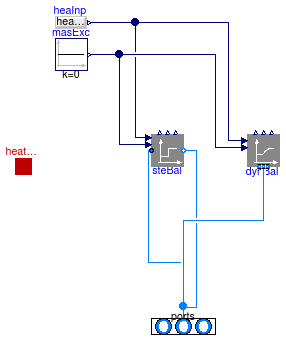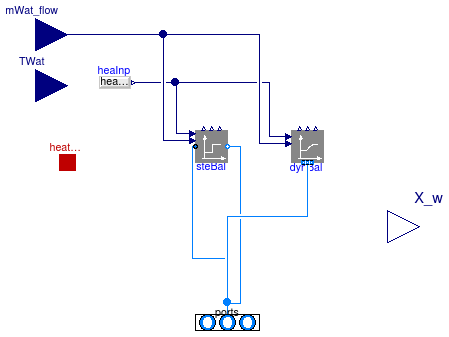

This package contains models for completely mixed volumes.
For most situations, the model Buildings.Fluid.MixingVolumes.MixingVolume should be used. The other models are only of interest if water should be added to or subtracted from the fluid volume, such as in a coil with water vapor condensation.
Extends from Modelica.Icons.VariantsPackage (Icon for package containing variants).| Name | Description |
|---|---|
| Mixing volume with inlet and outlet ports (flow reversal is allowed) | |
| Mixing volume with heat port for latent heat exchange, to be used with media that contain water | |
| Collection of models that illustrate model use and test models | |
| Package with base classes for Buildings.Fluid.MixingVolumes |
 Buildings.Fluid.MixingVolumes.MixingVolume
Buildings.Fluid.MixingVolumes.MixingVolume
This model represents an instantaneously mixed volume.
Potential and kinetic energy at the port are neglected,
and there is no pressure drop at the ports.
The volume can exchange heat through its heatPort.
The volume can be parameterized as a steady-state model or as dynamic model.
To increase the numerical robustness of the model, the parameter
prescribedHeatFlowRate can be set by the user.
This parameter only has an effect if the model has exactly two fluid ports connected,
and if it is used as a steady-state model.
Use the following settings:
prescribedHeatFlowRate=true if there is a model connected to heatPort
that computes the heat flow rate not as a function of the temperature difference
between the medium and an ambient temperature. Examples include an ideal electrical heater,
a pump that rejects heat into the fluid stream, or a chiller that removes heat based on a performance curve.
prescribedHeatFlowRate=true if the only means of heat flow at the heatPort
is computed as K * (T-heatPort.T), for some temperature T and some conductance K,
which may itself be a function of temperature or mass flow rate.
If the model is operated in steady-state and has two fluid ports connected,
then the same energy and mass balance implementation is used as in
steady-state component models, i.e., the use of actualStream
is not used for the properties at the port.
The implementation of these balance equations is done in the instances
dynBal for the dynamic balance and steBal
for the steady-state balance. Both models use the same input variables:
Q_flow is used to add sensible and latent heat to the fluid.
For example, Q_flow participates in the steady-state energy balance
port_b.h_outflow = inStream(port_a.h_outflow) + Q_flow * m_flowInv;
where m_flowInv approximates the expression 1/m_flow.
mXi_flow is used to add a species mass flow rate to the fluid.
For simple models that uses this model, see Buildings.Fluid.HeatExchangers.HeaterCoolerPrescribed and Buildings.Fluid.MassExchangers.HumidifierPrescribed.
Extends from Buildings.Fluid.MixingVolumes.BaseClasses.PartialMixingVolume (Partial mixing volume with inlet and outlet ports (flow reversal is allowed)).
| Type | Name | Default | Description |
|---|---|---|---|
| replaceable package Medium | PartialMedium | Medium in the component | |
| Volume | V | Volume [m3] | |
| Nominal condition | |||
| MassFlowRate | m_flow_nominal | Nominal mass flow rate [kg/s] | |
| Dynamics | |||
| Equations | |||
| Dynamics | energyDynamics | Modelica.Fluid.Types.Dynamic... | Formulation of energy balance |
| Dynamics | massDynamics | energyDynamics | Formulation of mass balance |
| Initialization | |||
| AbsolutePressure | p_start | Medium.p_default | Start value of pressure [Pa] |
| Temperature | T_start | Medium.T_default | Start value of temperature [K] |
| MassFraction | X_start[Medium.nX] | Medium.X_default | Start value of mass fractions m_i/m [kg/kg] |
| ExtraProperty | C_start[Medium.nC] | fill(0, Medium.nC) | Start value of trace substances |
| ExtraProperty | C_nominal[Medium.nC] | fill(1E-2, Medium.nC) | Nominal value of trace substances. (Set to typical order of magnitude.) |
| Advanced | |||
| MassFlowRate | m_flow_small | 1E-4*abs(m_flow_nominal) | Small mass flow rate for regularization of zero flow [kg/s] |
| Boolean | homotopyInitialization | true | = true, use homotopy method |
| Assumptions | |||
| Boolean | allowFlowReversal | system.allowFlowReversal | = true to allow flow reversal in medium, false restricts to design direction (ports[1] -> ports[2]). Used only if model has two ports. |
| Heat transfer | |||
| Boolean | prescribedHeatFlowRate | false | Set to true if the model has a prescribed heat flow at its heatPort |
| Type | Name | Description |
|---|---|---|
| VesselFluidPorts_b | ports[nPorts] | Fluid inlets and outlets |
| HeatPort_a | heatPort | Heat port connected to outflowing medium |
model MixingVolume "Mixing volume with inlet and outlet ports (flow reversal is allowed)" extends Buildings.Fluid.MixingVolumes.BaseClasses.PartialMixingVolume;protected Modelica.Blocks.Sources.Constant masExc(k=0) "Block to set mass exchange in volume"; Modelica.Blocks.Sources.RealExpression heaInp(y=heatPort.Q_flow) "Block to set heat input into volume"; equationconnect(heaInp.y, steBal.Q_flow); connect(heaInp.y, dynBal.Q_flow); connect(masExc.y, dynBal.mWat_flow); connect(masExc.y, steBal.mWat_flow); end MixingVolume;
 Buildings.Fluid.MixingVolumes.MixingVolumeMoistAir
Buildings.Fluid.MixingVolumes.MixingVolumeMoistAir
This model represents the same physics as
Buildings.Fluid.MixingVolumes.MixingVolume, but in addition, it allows
adding or subtracting water in liquid phase.
The mass flow rate of the added or subtracted water is
specified at the port mWat_flow.
The water flow rate is assumed to be added or subtracted at the
temperature of the input port TWat.
Adding water causes a change in
enthalpy and species concentration in the volume.
Note that this model can only be used with medium models that include water
as a substance. In particular, the medium model needs to implement the function
enthalpyOfLiquid(T) and the integer variable Water that
contains the index to the water substance. For medium that do not provide this
functionality, use
Buildings.Fluid.MixingVolumes.MixingVolume.
| Type | Name | Default | Description |
|---|---|---|---|
| replaceable package Medium | PartialMedium | Medium in the component | |
| Volume | V | Volume [m3] | |
| Nominal condition | |||
| MassFlowRate | m_flow_nominal | Nominal mass flow rate [kg/s] | |
| Dynamics | |||
| Equations | |||
| Dynamics | energyDynamics | Modelica.Fluid.Types.Dynamic... | Formulation of energy balance |
| Dynamics | massDynamics | energyDynamics | Formulation of mass balance |
| Initialization | |||
| AbsolutePressure | p_start | Medium.p_default | Start value of pressure [Pa] |
| Temperature | T_start | Medium.T_default | Start value of temperature [K] |
| MassFraction | X_start[Medium.nX] | Medium.X_default | Start value of mass fractions m_i/m [kg/kg] |
| ExtraProperty | C_start[Medium.nC] | fill(0, Medium.nC) | Start value of trace substances |
| ExtraProperty | C_nominal[Medium.nC] | fill(1E-2, Medium.nC) | Nominal value of trace substances. (Set to typical order of magnitude.) |
| Advanced | |||
| MassFlowRate | m_flow_small | 1E-4*abs(m_flow_nominal) | Small mass flow rate for regularization of zero flow [kg/s] |
| Boolean | homotopyInitialization | true | = true, use homotopy method |
| Assumptions | |||
| Boolean | allowFlowReversal | system.allowFlowReversal | = true to allow flow reversal in medium, false restricts to design direction (ports[1] -> ports[2]). Used only if model has two ports. |
| Heat transfer | |||
| Boolean | prescribedHeatFlowRate | false | Set to true if the model has a prescribed heat flow at its heatPort |
| Type | Name | Description |
|---|---|---|
| replaceable package Medium | Medium in the component | |
| VesselFluidPorts_b | ports[nPorts] | Fluid inlets and outlets |
| HeatPort_a | heatPort | Heat port connected to outflowing medium |
| input RealInput | mWat_flow | Water flow rate added into the medium [kg/s] |
| input RealInput | TWat | Temperature of liquid that is drained from or injected into volume [K] |
| output RealOutput | X_w | Species composition of medium |
model MixingVolumeMoistAir
"Mixing volume with heat port for latent heat exchange, to be used with media that contain water"
extends BaseClasses.PartialMixingVolume(
redeclare replaceable package Medium =
Modelica.Media.Interfaces.PartialCondensingGases,
steBal(final sensibleOnly = false));
Modelica.Blocks.Interfaces.RealInput mWat_flow(final quantity="MassFlowRate",
final unit = "kg/s")
"Water flow rate added into the medium";
Modelica.Blocks.Interfaces.RealInput TWat(final quantity="ThermodynamicTemperature",
final unit = "K", displayUnit = "degC", min=260)
"Temperature of liquid that is drained from or injected into volume";
Modelica.Blocks.Interfaces.RealOutput X_w "Species composition of medium";
Modelica.SIunits.HeatFlowRate HWat_flow = mWat_flow * Medium.enthalpyOfLiquid(TWat)
"Enthalpy flow rate of extracted water";
protected
parameter Integer i_w(fixed=false) "Index for water substance";
parameter Real s[Medium.nXi](each fixed=false)
"Vector with zero everywhere except where species is";
Modelica.Blocks.Sources.RealExpression heaInp(final y=
heatPort.Q_flow + HWat_flow) "Block to set heat input into volume";
initial algorithm
i_w := 0;
for i in 1:Medium.nXi loop
if Modelica.Utilities.Strings.isEqual(string1=Medium.substanceNames[i],
string2="Water",
caseSensitive=false) then
i_w := i;
s[i] := 1;
else
s[i] := 0;
end if;
end for;
assert(i_w > 0, "Substance 'water' is not present in medium '"
+ Medium.mediumName + "'.\n"
+ "Check medium model.");
equation
// Medium species concentration
X_w = s * Xi;
connect(heaInp.y, steBal.Q_flow);
connect(heaInp.y, dynBal.Q_flow);
connect(mWat_flow, steBal.mWat_flow);
connect(mWat_flow, dynBal.mWat_flow);
end MixingVolumeMoistAir;